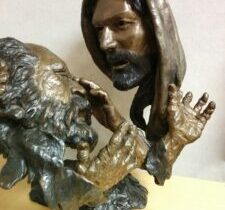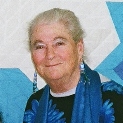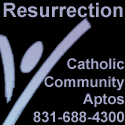Not as Humans See
 Sight is an amazing gift. A new baby’s eyes open and immediately floods of new sensations pour into existence for the child. It would all be overwhelmingly overpowering if the baby could see everything going on around it. Fortunately, at first babies don’t see things far away clearly.
Sight is an amazing gift. A new baby’s eyes open and immediately floods of new sensations pour into existence for the child. It would all be overwhelmingly overpowering if the baby could see everything going on around it. Fortunately, at first babies don’t see things far away clearly.
The face of mother or father are among the first to be seen – that’s a good distance for starters. Baby studies them carefully and begins to associate experiences with what is being perceived visually. Gradually, the distance increases and more wonders come into view. Experiences begin to be associated with what the eyes are reporting.
Baby reflects:
I cry and the tall folks around me pick me up and give me something to eat! I’m sitting in my car seat and I’m feeling pretty peaceful, but there’s one of those tall beings who pick me up when I cry. Oh boy, I’ll just cry and get picked up! No? Well then, I’ll complain some more. Oh. Now I can’t see them. Oh well, I guess I’ll just sit here quietly and see what comes next…
For the man born blind, the story of whose encounter with Jesus we hear in John’s Gospel, these experiences didn’t happen. He had to figure out the world in different ways. With much help from family and friends, he grew up, but the only way he had to support himself as an adult was to beg for alms from passers-by. A far cry from the experience of those who are blind in developed societies. (Jn 9:1-41)
In Jesus’ time, people believed that the light residing within people was what made it possible for them to see. If a person was born unable to see, there must not be any light within them. If there’s no light, then it’s only reasonable to assume that only darkness is there. Darkness is the realm of evil, so someone must have sinned in order for the child to be filled with darkness. For this reason, people asked Jesus, who had been the sinner whose actions resulted in the birth of a blind child: the parents or the child before birth? Jesus responded firmly, “Neither he nor his parents sinned; it is so that the works of God might be made visible through him.”
Jesus didn’t wait around to see what would happen to the man as life continued. He acted. “While I am in the world, I am the light of the world.” Then he spat on the clay ground and made some mud, which he smeared on the man’s eyes. He then told the man to go to a pool called Siloam (Sent) and wash off the mud. This pool was known to be a place where people were sometimes healed, so the man went. He washed off the mud and he gained the gift of sight, not the gradually expanding sight of an infant, but the sight of a person who could function in society.
The rest of the story tells of the consequences of this new experience in the man’s life. People were astonished. He was led to testify before the religious authorities about what had happened. (It was on a Sabbath that Jesus acted – how could he be from God if he broke the Sabbath by working?) Who was this Jesus after all? What did the man think of him? The man didn’t change his evaluation of the experience: the man who healed me must be from God because he “opened my eyes.”
Jesus went to find the man after he had been tossed out of his religious community by the authorities. He asked the man if he believed in the Son of Man, a title for the savior who was to come from God. The man became a follower of Jesus when he learned that Jesus was the one who had transformed his life.
This theme of sight and of light runs through the readings from the book of Samuel (16:1b, 6-7, 10-13a) and the letter to the Ephesians (5:8-14) as well.
When the Hebrew people decided they needed to have a king rather than be led by strong, wise men and women in times of danger or attack. God acquiesced to their request and Saul was anointed king. However, Saul didn’t turn out to be entirely faithful to God’s instructional leadership. God had someone else in mind to be the next king. The challenge was that kingship so commonly passes from father to son. Saul’s sons were not the ones God had in mind either!
The Lord sent the prophet Samuel to the village of Bethlehem, to a man named Jesse. One of Jesse’s sons would be the one he should anoint the one to be the next king. Jesse had eight sons. Any one of them might be the one, so one by one they were presented to Samuel. Each time Samuel thought, surely this would be the one. But none of the seven older sons was the one. Finally, they called David in from tending the sheep. David was still quite young. No one would have expected him to be the choice, yet this young man was the one chosen. Samuel anointed him in the presence of his family and the elders of the community. The spirit of the Lord, the holy breath of God, rushed upon him and remained with him.
As the Lord told Samuel, “Not as man (humankind) sees does God see, because man sees the appearance but the Lord looks into the heart.”
As members of the Followers of the Way, the early Christians in Ephesus were learning new ways to live. Many things that were acceptable behavior in their society were not “pleasing to the Lord.” Paul encouraged them: “You were once in darkness, but now you are light in the Lord. Live as children of light…” He advised them to act always with the assumption that what they were doing must be worthy of being seen – done in the light. Everything done in the light can be seen and everything that can be seen is light. He concludes, “Awake, O sleeper, and arise from the dead, and Christ will give you light.”
Light and sight are the keys. God sees in different ways than we do. Our human vision and understanding can go only just so far. Like the new baby, as we grow, we see more deeply and more clearly. As we grow in the experience of God’s love and life, our ability increases to perceive how far and deeply love extends and actually forms the substance of all life.
As we continue the journey to Holy Week and Easter, let’s ask the Lord to open our eyes too. To help us to see the face of Love all around us – in the people, the plants and animals, the environment, and the universe. To help us to value the unseen goodness of all of creation and treat it with reverence. To trust that all will be well, as long as we keep our eyes open in trust to the Lord, our God. And finally, to let that light be reflected into the world around us, letting the Light of Christ pour through us into our world.
Readings for the Fourth Sunday of Lent – Cycle A
Open My Eyes – Jesse Manibusan
Liturgy – Resurrection Catholic Community










